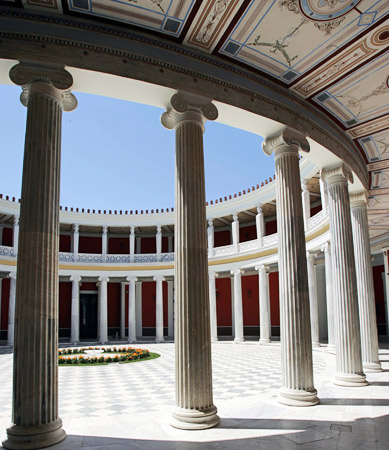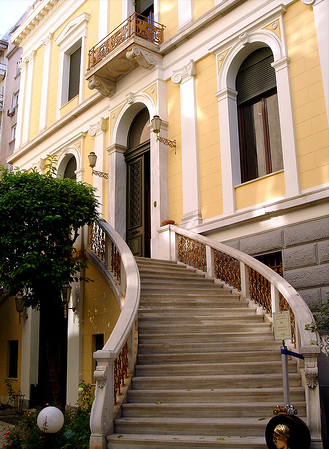|
|
Opening Ceremony – Welcome Reception
Sunday, September 20th, 2009
19:00- 21:00
Included in the Registration fee for participants
Cost for accompanying person: 30 €
Zappeion Megaron
The Zappeion Megaron is one of the most important venues for conferences, exhibitions, and special events in Europe. Located in the historic centre of Athens, walking distance from the Acropolis and the marble Panathinaic Stadium of the 1896 Olympic Games, the Zappeion Exhibition Hall is surrounded by over 200,000 square meters of gardens with meandering paths, fountains and over 70 neoclassical sculptures.
In 1888 the Zappeion Exhibition Hall was one of the first buildings in Europe specifically designed for exhibitions and conferences. An extensive interior and exterior renovation, completed in 2006, restored the building to its original splendor while, at the same time, state of the art technology was introduced to the listed building.
The Zappeion Exhibition Hall has served as the headquarters for the Greek EU Presidency and the Press Centre for the Ministry of the Press during the 2004 Olympic Games. Read more
 In the 1850's, when the issue of reviving ancient ceremonies and contests was being discussed in Greece, Evangelis Zappas, a native of the Greek province of Epiros, lived in Romania where he had made his fortune. He began to consider how such institutions could be revived, and even proposed that they be called 'Olympic'. In the 1850's, when the issue of reviving ancient ceremonies and contests was being discussed in Greece, Evangelis Zappas, a native of the Greek province of Epiros, lived in Romania where he had made his fortune. He began to consider how such institutions could be revived, and even proposed that they be called 'Olympic'.
Zappas would bear the cost of this event, as well as that of constructing an Olympic building to house an exhibition of samples of Greek art and industry. The building would also function as a museum displaying antiquities . To expedite this plan, he immediately sent 2000 Austrian florins to cover the costs of the First Olympia, which was also called the First Zappeian Olympiad.
In 1869 the Parliament of the Hellenes made approximately 80,000 sq. meters of public land available between the temple of Olympian Zeus and what, were then, the palace gardens. This took into account Zappas wish for the building to be as close as possible to the Stadium. After some delays, the cornerstone was laid on January 20th,1874. In the mid- 1880s, Konstantinos Zappas assigned the Danish architect Theophil Hansen to create a new design, even if it meant sacrificing the walls that had already been built. But the professional bickering between these well known architects of the era and the hints of serious financial misappropriation led to long delays, and the works came to a halt twice. The building was eventually inaugurated with all due pomp on October 20th,1888.
The Zappeion Exhibition Hall was the first building in the world to be constructed in order to serve Olympic needs. Its architecture is in the neoclassical order, with a Corinthian portico, and an organization of spaces that is fully in harmony with the purpose for which it was built. This building, the three-arched stone bridge over the Ilissus River that had been repaired, also at the expense of Evangelis Zappas, and the surrounding gardens give us a charming picture of Athens in the early 20th century.
During the first modern Olympic Games in 1896, the fencing events were hosted in its circular atrium; during the second International Olympic Games in 1906, the lack of infrastructure and facilities led to its being used as the "Olympic Village".
In addition, starting in 1936 and for the next 40 years, it hosted the country's first state radio station. In 1940 it was converted into a hospital; the following year it was commandeered by the German occupation army after which it became a storehouse and later a barracks (1944). It was even bombed during the same year.
The Zappeion Exhibition Hall has witnessed the history of Athens for the past 120 years. It has been a key site for some of the nation's most significant moments, and has always been integrally linked to the Olympic Movement. Even though its uses were varied, it has become a landmark in the Greek capital, thus fulfilling the donor's initial wishes.
|
| |
|
| |
PROGRAM
|
19:00-19:15
|
Gathering, welcome drink |
| 19:15-19:30 |
Opening Address by Professor Prokopis Pavlopoulos
Welcome Speech by Mr. George Bolanis, Managing Director of HeNAA
|
| 19:30-19:45 |
Welcome Address by Kevin Bradley, IASA President |
| 19:45-20:10 |
Live music performance from the Mixed Choir of the Music Ensembles of the City of Athens |
| 20:10-21:00 |
Cocktail Reception |
|
|
|
IASA 40 years Celebretion
Tuesday, September 22nd, 2009
18:30-20:30
Included in the Registration fee for participants
 Garden of the “Iliou Melathron”, Numismatic Museum Athens Garden of the “Iliou Melathron”, Numismatic Museum Athens
The Numismatic Museum is one of the oldest public museums in Greece.It was established in 1834, the same year as the National Archaeological Museum.
The love for Antiquity, prevalent at the time in Europe, and the recent foundation of the Modern Greek state had created the conditions of protecting the national cultural heritage. Hence, from the beginning, the history of the Museum was directly related with that of the Modern Greek state, the social circumstances and the cultural directives of each age. However, a decisive role in its progress was played by the personalities of those who directed it.
The “Iliou Melathron”, is located in downtown Athens, It was built in 1878-1879 and designed by the German architect Ernst Ziller, as the residence of the Schliemann family.
Its name, meaning the Palace of Troy, was associated with the discovery of the ancient city by Heinrich Schliemann.
It is a two-storey building impressively decorated. The first floor functioned mainly as the place where the social life of the family unfolded. The Hesperides Hall was designed for the receptions and the literature salon for literary evenings; the guest room and the dining room were situated around a central area. The bedrooms, offices and the library were on the second floor. The auxiliary areas, the servants’ rooms and a hall where the artifacts from the excavations in Troy were in display, were located on the ground floor. The coach-house and the stable were at the back of the house in the big garden. the garden of the Iliou Melathron, a small green oasis in downtown Athens. The garden, of 800m2, contains numerous plants of the Greek flora and is decorated with copies of ancient Greek statues.
www.nma.gr
PROGRAM
| 18:30-18:45 |
Gathering, welcome drink |
| 18:45-18:50 |
Welcome Address by Kevin Bradley, IASA President |
| 18:50-19:20 |
From the Editors: Perspectives on IASA as reflected through Editorials in IASA Newsletters, Bulletins and the IASA Journal• |
| 19:20-19:30 |
Presentation of the anniversarial cd sponsored by HeNAA |
| 19:30-19:50 |
speeches by other IASA historical members |
| 19:50-20:20 |
Live music performance from the Sixteto of the Contemporary Music Orchestra and the ERT Music Ensembles |
| 20:20-21:00 |
Cocktail Reception |
|
|
|
Farewell Dinner
Friday, September 25th, 2009
20:30
Cost per person: 75 € (transportation included)
Asteras Seaside Dreams
At the beach, with a view of the endless blue of the Argosaronicos open sea, the Asteras Seaside Dreams offers you the most beautiful place for the most memorable events. Creating a wonderful feeling, elevated from the sea all while touching the sand and the beach, Dreams makes you feel as if you are at your own private beach of the Aegean. The exclusive use of the setting combined with a superb service, and eclectic tastes definitely ensure a successful event.
Without the need to leave Athens, Asteras Glyfadas Seaside Dreams offers an ideal setting, which most certainly will carry you away to a fabulous island setting.
|
|
|

 Print
Print 
 Print
Print